Lớp phụ (Subclass) cá vây tia >
Osteoglossiformes (Bony tongues) >
Arapaimidae (Bonytongues)
Etymology: Heterotis: Greek, heteros = other + Greek, ous, otis = ear (Ref. 45335); niloticus: Named after M. Ehrenberg, scientist (Ref. 50686).
Môi trường / Khí hậu / Phạm vi
Sinh thái học
; Nước ngọt Tầng nổi; Mức độ sâu 1 - ? m (Ref. 13851). Tropical; 25°C - 30°C (Ref. 2060), preferred ?; 16°N - 3°N, 17°W - 37°E
Africa: native in all the basins of the Sahelo-Sudanese region, the Senegal, Gambia, Corubal, Volta, Ouémé, Niger, Bénoue, Chad and Nile basins and Lake Turkana (Ref. 2920, Ref. 3012, Ref. 3514). Successful introductions in the storage reservoirs of Côte d'Ivoire, the Cross, Sanaga, Nyong and Ogowe rivers and the lower and middle Congo basin, including Ubangui and Kasaï (Ref. 2920); rapidly enlarged its distribution in the Lualaba (upper Congo basin) after extraordinary inundations in 1979 (Ref. 51906). Also introduced in Madagascar (Ref. 13333). Several countries report adverse ecological impact after introduction.
Length at first maturity / Bộ gần gũi / Khối lượng (Trọng lượng) / Age
Maturity: Lm ?, range 40 - 40 cm
Max length : 100.0 cm SL con đực/không giới tính; (Ref. 31256); Khối lượng cực đại được công bố: 10.2 kg (Ref. 2920)
Các tia vây lưng cứng (tổng cộng): 0; Các vây lưng mềm (tổng cộng): 32-37; Tia cứng vây hậu môn 0; Tia mềm vây hậu môn: 34 - 39; Động vật có xương sống: 66 - 69. Elongated and robust body, its height 3.5 to 5 times in standard length (Ref. 2920). Relatively short head, its length 3.5 to 5 times in standard length (Ref. 2920, Ref. 5156). Dermal bones of the cranium are deeply carved by large sensory pits (Ref. 1878, Ref. 2920). The lips are thick and there is a dermal flap on the border of the gill cover (Ref. 13851). Conical teeth (Ref. 5156). Dorsal and anal fins, which are spineless, elongated and posteriorly positioned, ending close to the small, rounded caudal fin (Ref. 3032, Ref. 13851, Ref. 28714, Ref. 30488). Caudal peduncle very short (Ref. 2756, Ref. 3054, Ref. 3069). Strong, large scales (Ref. 28714, Ref. 30488), oval with the exposed portion thick and corrugated, with a more or less vermiform sculpture (Ref. 53264): 34-40 lateral-line scales, 2.5/6 scales on the lateral side of the body before the pelvic fin, 5-6 scales between dorsal and anal fin (Ref. 367, Ref. 2756, Ref. 2920, Ref. 5156). The lateral line is extending in a straight line from above the operculum to the middle of the caudal peduncle (Ref. 1878). The number of gill rakers increases with the length; 33 (young) to 98 on the ceratobranchial and 21 (young) to 76 on the epibranchial (Ref. 2920). Young specimens possess external gills (Ref. 30488). Uniform gray, brown or bronze colored (Ref. 2920), darker during the reproduction-period (Ref. 367). Young specimens are often marked with dark longitudinal bands and scales with an oval spot in the posterior zone of the anal and dorsal fin (Ref. 2920).
Maximum observed length in Lake Kainji: 100 cm, observed weight: 10000 g (Ref. 3034, Ref. 3799). Young found in swampy places among aquatic vegetation (Ref. 5156, Ref. 30488); adults live in the open water of rivers and lakes, where they can be found in the pelagic zone as well as the littoral zone (Ref. 5156). Are able to survive in deoxygenated waters; the hardiness of this fish, together with its great growth rate make it a candidate for aquaculture in Africa and it has been transported to a number of countries for this purpose (Ref. 1739, Ref. 50623). Escapees from ponds into the wild resulted in established populations, which form the basis for fisheries (Ref. 1739). Are considered as mud-feeders (Ref. 6160), but in West Africa also as phytoplankton feeders (Ref. 3023, Ref. 31256). Feed mostly on plankton, being the only plankton-feeders of the Osteoglossidae (Ref. 13851). It has a suprabranchial organ which has a sensory function, but also a mechanic function in concentrating the little food particles (Ref. 3012, Ref. 50624). During breeding, mature adults create a circular nest in swamps (Ref. 13851, Ref. 26281, Ref. 41544). The young leave the nest after a few days and are guarded by the male (Ref. 26281).
Heterotis niloticus breeds in the wet season in swamps and floodplains (Ref. 28714). It builds a circular nest about 1 m in diameter and 20 to 60 cm deep (Ref. 26281). The rim of the nest is a high wall formed out of plant chunks, about 15-20 cm thick and projecting above the water surface; the bottom is a clean platform of clay or mud (Ref. 26281). After the spawning act the fish leave by way of a hole in the wall, through which, 5 days later, the young leave the nest and are guarded by the male (Ref. 26281). Also Ref. 3074, Ref. 10609, Ref. 36900.
Paugy, D., 1990. Osteoglossidae. p. 114-115. In C. Lévêque, D. Paugy and G.G. Teugels (eds.) Faune des poissons d'eaux douces et saumâtres de l'Afrique de l'Ouest. Tome 1. Coll. Faune Trop. n°XXVIII. Musée Royal de l'Afrique Centrale, Tervuren and Éditions de l'ORSTOM, Paris. 384 p. (Ref. 2920)
IUCN Red List Status (Ref. 115185)
CITES (Ref. 94142)
Not Evaluated
Threat to humans
Potential pest (Ref. 40814)
Human uses
Các nghề cá: Tính thương mại; Nuôi trồng thủy sản: Tính thương mại; Bể nuôi cá: Tính thương mại
Các công cụ
Special reports
Download XML
Các nguồn internet
